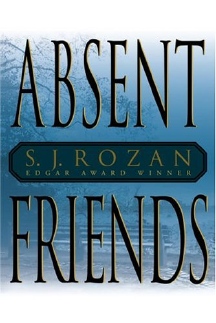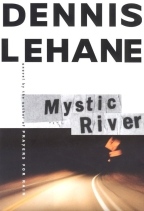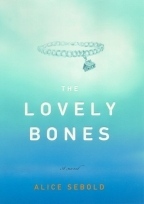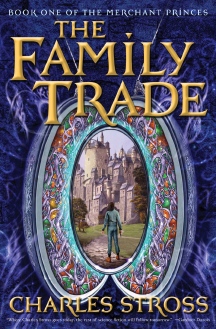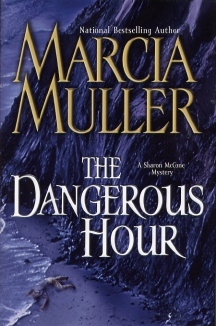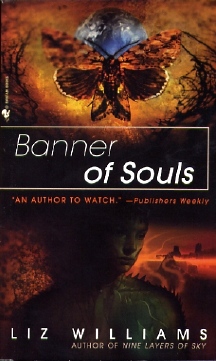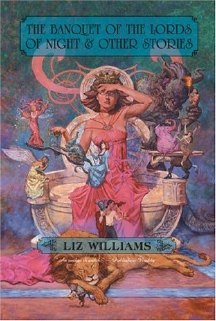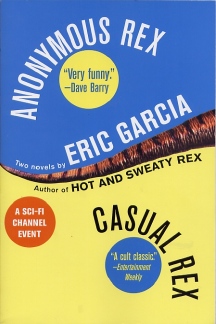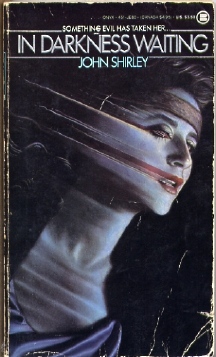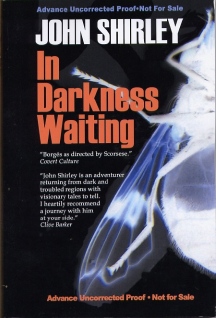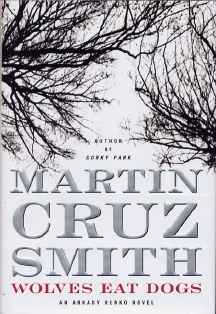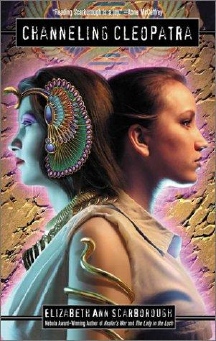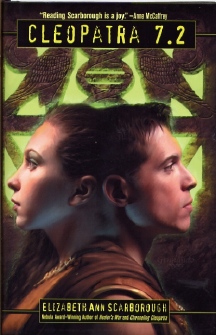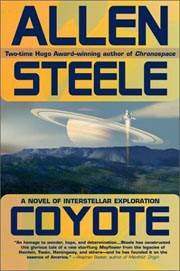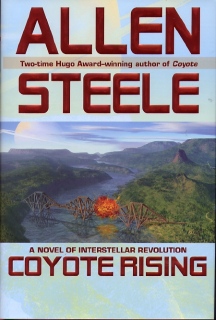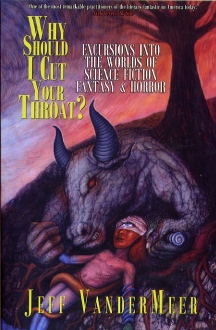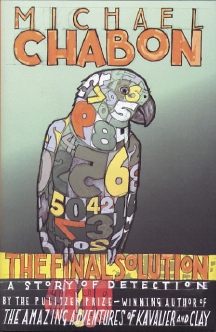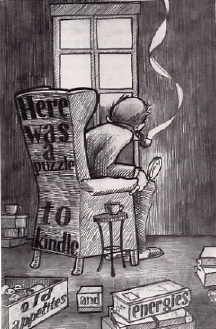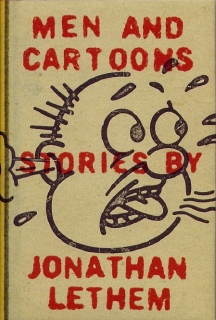|
|
|
This Just In...News from the Agony Column
|
11-19-04: Searching, searching, searching |
||||||||||||||||
| Rozan & Stross
Vs. Bookstore Shelves by Terry D'Auray & ==== Rick Kleffel
So, where to look? My statistically invalid sampling of two bookstores yielded completely egalitarian treatment: one shelved 'Absent Friends' with the mysteries, while the other put it with general fiction. (Although, to be absolutely, anally correct, the store classifying it as general fiction displayed it on a big table one side of which was generally mysteries and three sides of which were generally not. That 'Absent Friends' was on the generally-not-mystery side may be attributed to ooze rather than evaluation. Or, it may be a simply brilliant solution to the genre cross-over problem, a special degenre-ized zone for those awkward in-between titles.)
The genre/general fiction classification issue has never much stirred my blood. (I'd much prefer to read the books themselves, rather than the articles and/or rants about their classification). But S.J. Rozan made a rather interesting point about all this in an interview in the October/November issue of 'Black Raven'. When asked if she considered 'Absent Friends' a crime novel, she said yes; but she then admitted she was "thrilled" when PW reviewed it as general fiction, a signal that it was "bigger than what they (PW) considers niche genre fiction". Rozan then goes on to say:
I remember
years ago asking the owner of a (not particularly good) bookstore
why he didn't just shelve "cross-over" books in
both places, so all categories of readers had a chance of
finding them. His reply was that it made it too hard to keep
track of inventory. So, there you go. Genre schmenre – it's
all about tracking inventory! (Terry D'Auray)
Tor has designed and published this novel as a fantasy, and to be sure, it is a fantasy in the sense that it includes one fantastic element. But in style, content and execution, it's a wonderful, exciting, engaging novel of suspense. Fantasy, shmantasy -- ' The Family Trade' needs an Extreme Makeover! Charlie's written a novel that to my mind will absolutely appeal to readers of suspense fiction, in particular, the work of Marcia Muller ('The Dangerous Hour') or Joe R. Lansdale ('Sunset and Sawdust'). Like these authors, Stross casts strong, smart women in the lead roles. He shares with them a sassy voice, an undercurrent of humor and a hardheaded approach to problem solving. Readers of Muller and Lansdale expect their characters to be smart. Sharon McCone doesn't go into the alley unarmed. Sunset Jones carries a gun. She uses it early and often. Miriam Beckstein, the heroine of 'The Family Trade', may be able to walk from our world to a seventeenth-century version of our world. But she carries a gun, a camera and a cell phone with her. The worlds she walks between operate on the same principles as those of McCone and Jones. Guns and money shape and move the people in 'The Family Trade'. This novel has much, much more in common with 'The Dangerous Hour' than it does with 'The Fellowship of the Ring'. There's no magic in Miriam's world. There is, however, an enticing economic opportunity. Readers who enjoy crime fiction with a dollop -- and just one quite judicious dollop -- of imagination will go nuts over 'The Family Trade'. Stross' prose is attention getting and gripping throughout. This novel is a quintessential page-turner, but filled with entertaining speculation about the intricacies of how money moves about and why. But 'The Family Trade' is most likely to be filed with huge, plodding fantasies and marketed to a crowd that expects dragons, elves and wizards, none of which appear. Now, my take is that even if you expect elves and dragons, you'll be captivated enough by the gripping plot and prose to want the sequel, like, now! But because it's going to be shelved with SF&F, and because the cover illustration has a definite SF&F vibe, your average Sarah Paretsky fan is likely to pass this by. If you are a Sarah Paretsky fan, and you're reading this, don't let 'The Family Trade' escape you! As much as it pains you, step over to the land of spaceships and wizards, and buy this book -- or at least, pick it up and read the first page. My guess is you won't want to leave without finding out what happens. There's the damage done by the genre-fication of all fiction, the cost of inventory concerns. The cost to readers is that they often miss a book they might otherwise greatly enjoy. How many SF fans are missing out on Jasper Fforde's novels because in many bookstores, he's filed as mystery? And conversely, how many mystery fans are missing out on F. Paul Wilson's Repairman Jack novels because they're filed as SF or horror? That's why we toil away here with non-random rants and relentless reviews. If you're a reader, you've only got so much time in the bookstore to figure out what you want. If the bookstores and publishers won't help you buy books, then we will. |
||||||||||||||||
|
11-17-04: 'In Darkness Waiting' for like, Sixteen Years! ; 'Wolves Eat Dogs' for Martin Cruz Smith |
||||||
John
Shirley's MMPB Classic Re-issued
OK, yes, I know, dark fantasy, new weird, or even the Old Peculiar, as Graham Joyce calls it. I'm fond of the latter, especially as it's also a rather wonderful dark, bitter beer that I used to drink in my misspent youth. Driving down to the British deli in Irvine, picking up a four-pack of OP and a steak and kidney pie -- those were the days. Dark fantasy, hoping to draw in the bazillions of people who have seen LOTR movies and have decided that they now love fantasy. You've got to love them. They're keeping genre fiction afloat. But what happens when they pick up a novel labeled "Dark Fantasy" and find out it's a vampire novel? They may lose their newly found affection. Now to be clear, the label dark fantasy is playing on the term fantasy in its loosest definition, that is, events of a fantastic nature. This is the definition of fantasy behind the mind-bogglingly wonderful 'Encyclopedia of Fantasy' mastered by the encyclopedic minds of John Grant and John Clute. To my mind, only these two have the right to use that term. Publishers hoping to fob off some loose-fanged vampire love-story should step aside. But then, come to think of it, many a person who found their love of the fantastic in the LOTR movies might be just fine with erotic vampires. Hey, it's all "genre fiction", it sells and advances the causes of many a fine mid-list author. I say: Bring It On.
'In Darkness Waiting' excels because Shirley has managed to concoct a wonderfully imaginative horrific metaphor for what he calls 'Empathy Suppression Syndrome' -- that is, our ability to disconnect from our own humanity and torture, maim and kill one another if called to in the name of God, country, or the voices in our head. But then -- they're all voices in our head, aren’t they? And they whisper so sweetly. What Shirley creates with 'In Darkness Waiting' is exquisitely imagined and grippingly plotted. All you need to do is surrender. Even when it came out, I thought that 'In Darkness Waiting' deserved a hardcover publication. We can then thank the seemingly ubiquitous Paula Guran at writers.com -- the folks who brought back Dennis Etchison's out-of-print Stealth Press omnibus collection, 'Talking in the Dark' -- for finally, finally bringing out a hardcover and trade paperback version of 'In Darkness Waiting'. The publication date is February 2005, but I suspect it may be ready sooner. And I also would suggest that readers ask their local independent and even their (shudder) chain bookstores to order the book for them, though you can get them direct from the publisher. It probably doesn't matter. Just do whatever you have to get your hands on this volume. It's deeply disturbing and engagingly page turning. And thanks to (i) infrapress and writers.com, it's no longer waiting out there in the darkness. It's here. You’re ready. Have at it. |
||||||
Enter
the Zone of Exclusion With Arkady Renko
That's certainly because his breakout novel (as they like to call them) was 'Gorky Park', a quirky mystery set in Russia in the midst of the Cold War. Detective Arkady Renko was memorable enough to get resurrected in 'Polar Star', which featured a wonderfully gruesome set piece involving eels. Lots of eels. It still gets mentioned around the house any time his name, or the Bering Sea comes up. Or eels. Arkady Renko is back in 'Wolves Eat Dogs' (Simon & Schuster, November 16, 2004, $25.95). Unfortunately for Arkady, he's back in the Zone of Exclusion. When one of the new Russian billionaires is found dead in his high-tech, high-security, locked door haven, his comrades want to call it a suicide. Renko is not so sure. When another man is found dead, this time inside the Zone of Exclusion that surrounds Chernobyl, Renko is sent to investigate as a punishment for not obeying orders. There he finds a setting not unlike that portrayed in Boris and Arkady Strugatsky's science fiction classic novel 'Roadside Picnic', adapted into a singularly eerie movie by Andrei Tarkovsky called 'Stalker'. Scientists, and former residents who have become scavengers, live in a ring around the zone, and enter it in risky excursions to seek salvage. Renko seeks the truth behind the murders, but finds an increasingly murky mix of the Russian mafia, mysterious Americans and brutal local bullies. Smith offers a very nicely turned dark vision and has for quite some time. In a sense, his work is still informed by his long-ago fling with writing horror. If, like me, you've managed to sort of keep up with Renko, this looks as if it might be the best yet. I mean, who could not want to enter the Zone of Exclusion? The name itself is an invitation. |
|
11-16-04: Channeling 'Cleopatra 7.2' With Elizabeth Scarborough; Allen Steele's 'Coyote Rising' |
||||||
Walk
Like An Egyptian
The progenitor for 'Cleopatra 7.2' (Ace / Penguin Putnam; December 7, 2004; $23.95) was the frothy 'Channeling Cleopatra', an odd combination of hand-waving science fiction, goofy comedy and running 'round the desert mystery-chase scenes. The premise is not one of those that will bear up under close examination. Nucore has developed a method of "blending" DNA extracted from the dead into the DNA of the living in such a way that the dead are brought to life as a second personality within the living host. Leda Hubbard (not a relative of L. Ron, but she should be!) wanted to be an Egyptologist, but it didn’t happen. She's a forensic anthropologist, and she's not pulling down a guest gig as the consultant for any of the plethora of forensic TV shows. So when an old friend -- well, really the old friend's husband, who has blended his wife's DNA into himself, so can never, ever get any rest -- calls up Leda and says, "Honey, I've got this swan, I want you to meet..." No, really. The phrase is "long story short", and the answer is, Leda gets Cleopatra's DNA and her personality rattling around in her head. Written in a sort of tribute to Barbara Michaels and Elizabeth Peters, 'Channeling Cleopatra' opted to stay strictly on the light side. And speaking of characters we liked, while Cleo and Leda were the main characters, Leda's father, the swan, no, no, sorry about that, no swan in sight -- Leda's father, Duke, stole the show and provided the best moments of humor.
Of course, back home, the reception to Leda's example of blending technology is not particularly welcoming. The blended are disappearing. Gabriella is -- at Cleo's urging -- looking for a suitable recipient for Marc Antony's DNA. (I used the world silly earlier, didn’t I? I hope so.) Of course the suitable candidate quickly becomes embroiled in a Middle East political upheaval. Stir lightly, serve with ample helpings of Duke. But I'm not certain that Duke plays the prominent part in the proceedings that he earned in the last outing. That's the trick of writing sequels, in that writers have to respond to what the readers enjoyed most of the first book, and alas, that's not always going to be what you, the writer, planned. |
||||||
Life,
Liberty and the Pursuit of Space Travel
Steele gave a speech to the House of Representatives in 2002 on the importance of space flight, which he's got archived at his website. He's a passionate and intelligent supporter of the proposition that mankind should explore space as soon -- and as intelligently -- as possible. One hopes he made some inroads on that proposition with his speech, but...one would be ill advised to hold one's breath in anticipation of results.
In 'Coyote', Steele clearly created a world that would not only allow but demand more exploration. He's also got a pretty intriguing cast of characters, who tend to walk the line between freedom fighter and terrorist. He's used science fiction to force an examination of the present that is likely to prove unflattering. My suspicion is that readers who enjoyed 'Coyote' would be well advised to pick up the sequel, if for no other reason than that it seems like the kind of book that may not get a real positive reception except in SF circles. And while we're at it, readers have a chance to get in on this series, because there are clearly going to be more books. You're only one book behind at this moment, and if you pop out now and buy 'Coyote', then by the time you finish, 'Coyote Rising' will have arrived on your bookstore shelves. No amnesty required! Allen Steele Responds: "...about COYOTE and COYOTE RISING...I noted that you drew an association between them and the testimony I gave to the House space subcommittee a few years ago. Considering that I was writing COYOTE when I did that, no doubt there was a crossover effect. One thing to point out, though, is that -- at least as it now stands -- the "Coyote" isn't going to continue indefinitely, but rather will come to an end. I've just turned in the third and final novel, COYOTE FRONTIER, to be published by Ace in December `05, and this book pretty much brings everything to a close. I may write stand-alone stories set on Coyote, and I'm also intending to do a spinoff novel set in the same "universe," but that's pretty much it. There won't be a GOD EMPEROR OF COYOTE or MASTERMIND OF COYOTE or even ABBOTT AND COSTELLO GO TO COYOTE. On the other hand, considering that I didn't originally intend to write a second novel, let alone a third, this too may change." Thanks, Allen -- it's great to hear this. |
|
11-15-04: Literary Amnesty; Cemetery Dance Issue #50; What is Jeff VanderMeer's 'Why Should I Cut Your Throat?'? |
||||||||||
Non-Fiction By Horror Writers for $1000: "Pontificate! Argue! Rant! Whine!"
VanderMeer is the author of such luminous and numinous fiction works as 'Veniss Underground', 'City of Saints and Madmen' and the short story collection 'Secret Life'. I mean -- look, if it's not impeccable, it must be peccable, right, no matter what spell check says. And 'Why...? is if nothing else peccable, because VanderMeer's not afraid to make a literary omelet, or at least line up the eggs and break regardless of the size of the egos. You get Yet Another Harlan Ellison Story, you get a Michael Moorcock, rock star, you get reviews of stuff you'll love and maybe some reviews of stuff you'll hate. What you won’t get, ever, is something you could easily find in any other venue. You'll get strong opinions about actually weird fiction, much of it translated, and peculiar beyond being about monsters, psychic powers and whatnot. 'Why...?' is divided into three main sections; 'Career and Craft', 'Reviews' and 'Criticism'. You'll start up with a salty preamble, skip past a couple of interludes and finish off with a coda, but don't plan on getting there too fast. You'll want to draw out the reading of Jeff's non-fiction, to immediately follow-up on some of the reviews he offers and give yourself time to soak up his thoughts about the writing life, the fiscal death and highly detailed discussions of odd books few normal people have ever heard about. What makes the book work is VanderMeer's often-unedited voice. He's brash, annoying, to the point and perceptive. He pops up with knowledge that by rights should be locked away in a dusty suitcase or the bottom drawer of a desk hidden in an abandoned building. VanderMeer, as we have come to know from his fiction brings one particularly strong point to his writing. He's unafraid -- even of himself. |
||||||||||
No Half Measures
You can see lots of the fiction roster on the front cover; Douglas Clegg, Glen Hirshberg, a new poem by Ray Bradbury, Bentley Little, Norman Partridge, Ray Garton, and even a very nicely done ghoulish, garish comic by Glenn Chadbourne. The non-fiction roster is equally stellar. This issue includes interviews with Stephen King, Elizabeth Massie, Mike Mignola, Genevieve Jollifee and Mick Garris. Joseph Nassise talks to Earthling Publications, Norman Partridge reminisces about 'the First Dance', and various author (including YT) 'fess up and spill the beans on 'The Three Genre Books I'm Embarrassed to Admit I've Not Read'. Thank you Robert, for putting up with mine whine! Of special note is the art for this issue, including Bernie Wrightson's cover painting, which is from the "Frank Darabont collection", and contributions by genre favorite Allen Kozowski. But one can't neglect the fine work of Audre, Randy Broecker, Alex McVey, Keith Minnion, and Chad Savage. The fine design, layout and the actual pages-and-paper publication of CD have been among the great strengths that make this issue a milestone we should care about. Remember -- they're doing limited edition hardcover versions of the magazine, and if you're inclined, this would be a good issue to look at in hardcover. But no matter the cover, CD is always worth your time, because, bottom line, it's packed with great writing. And that demands only that you read it! |
||||||||||
Literary Amnesty
Last week, when I finally saw 'The Final Solution' by Michael Chabon at Bookshop Santa Cruz and Capitola Book Café and BookWorks Aptos, after being clubbed over the head three times, well, I finally got the message. Picking it up, hefting it a bit and then looking at the similarly sized 'Men and Cartoons' by Jonathan Lethem, I realized that there was a fully and solely literary equivalent to serial amnesty. That would be Literary Amnesty, the gift given by those writers of huge, dense, award-winning works of great literature when they issue a short, readable, accessible piece of fiction for "the rest of us", as it were. Chabon, for example, has been on my to-buy list for years. I'm still kicking myself for not nabbing the signed firsts of 'The Amazing Adventures of Kavalier and Klay' that some bookstore was offering in a catalogue for $45 a pop. What was the matter with me? What was I thinking? I wasn't thinking, that much was clear. I was floating along, reading monster books and thinking I'd get to that one later. Well, it's definitely later now. And Chabon has just brought forth the kind of novella that sets my literary sensibilities on full alert.
Gorgeously illustrated by Jay Ryan, 'The Final Solution' more than lives up to the multiple implications of its title. Beautifully. Powerfully. Briefly. And that's the rub. Readers can get a full dose of Chabon's genius in a chunk easily read, leavened with illustrations and meaty enough to send you to the bookstore to pick up the rest of his oeuvre. And yes, you'll be ready to read an "oeuvre" after reading 'The Final Solution'. It looks to strike the balance between accessibility and ambition. Similarly, though I've written about it before, it pays to mention Jonathan Lethem's 'Men and Cartoons'. Now, I understand that many of you might be a bit hesitant to pick his last year's masterpiece, 'The Fortress of Solitude'. It's a big book and it implies a big reading commitment. But if you have any hesitation, you get a perfect and very concise entrée into the novel with 'The Vision' and 'Super Goat Man', two stories from the collection which seem to inhabit the same universe as the novel. It's a universe you'll find in exactly one other place; between the covers of 'The Fortress of Solitude'. I just saw the hardcover version of this fantastic -- in all senses of the word -- novel as a remainder over at Bookshop Santa Cruz. The mind boggles. The wonders are there. You've even been given literary amnesty for the crimes you've perpetrated on yourself. Literary omission is the perfect crime. Nobody knows what you're missing but you. And now that you know it, let me suggest that you can take the first step to prevent literary omission. Accept literary amnesty. Life is short, and so are these books. |
